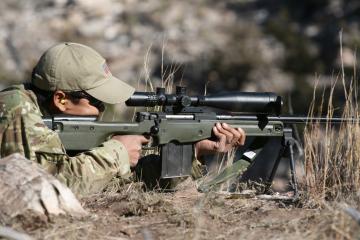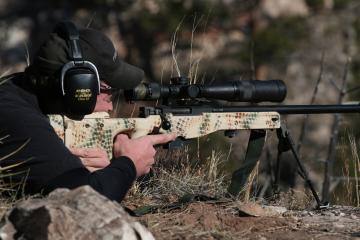It is divided into three sections. The first is about the rifle and gear. The second discusses trajectory and optics selection in depth. The third explains how to put everything together to make hits on targets in the field.
Need training? - Click here for the THUNDER BEAST ARMS TRAINING GROUP

PART I: THE RIFLE & GEAR - priorities, cost, calibers, rifles, ammunition, scopes, range-finders, ancillary gear, spotting, data PART II: OPTICS - ballistics, elevation, wind, lead, data cards, dialing elevation, parallax, first focal plane vs. second focal plane, elevation adjustment & travel, clicks, zero-stop, single- vs. multi-turn knobs, bullet-drop compensators (BDC), tube diameter, reticle features, MIL vs. MOA, reticle illumination, brightness, magnification, objective size, specific recommendations PART III: SHOOTING - zeroing, finding a range, targets and placement, packing up, arrival, target location, positioning, making scope adjustments, engagement, follow-up, shooter/spotter communication, efficiency
Join the discussion: What Is Practical Long-Range Rifle Shooting?
Practical precision rifle shooting involves engaging small and/or
distant targets at the limit of weapon, ammunition, and shooter
capability under time pressure in field settings.
Generally, these include everything a rifleman is likely to find in any "sniper", "tactical", or "field" rifle match. The typical platform is a bolt action rifle, though an auto-loader of sufficient accuracy and appropriate caliber can do the job with some trade-offs. For our purposes, consider "long range" to reach to the load's trans-sonic boundary (the point at which the bullet slows to 15 to 20 percent faster than Mach 1). For example, with typical 308 loads and rifles, we are interested in ranges from 25 yards out to about 700-1100 yards, depending on ambient conditions and the particular load.
It's About Making Hits, Not Having Perfect Gear
All of the questions discussed in this article have been and will continue to be debated to death on
the internet, at the hunting camp, and at the gun-shop. Equipment choices are important, but not something to obsess over. It is more important to get some quality
gear and get shooting, than it is to get paralyzed with indecision due to too many choices, or
change equipment too often to get good.
Remember, long-range practical shooting is about making hits in the field. Practice and skill are more important than equipment. Pay Once For Good Gear - It's Worth It
Some of the equipment discussed in this article is expensive-- really expensive. Let's get this out
of the way: long range shooting is not cheap, but the rifles and optics are not where the expense
lies. Long range shooting is expensive because it requires a lot of practice to become really good,
and practice means time and ammunition.
Many people balk at spending $1000 or more on a rifle or scope. This is misguided. Spending money for good equipment in these two areas especially are some of the best places to spend money in a precision rifle system. Along with the rifle action, stock, and mounts, these costs are fixed over the life of the rifle. The cost of training, ammunition, and barrels dramatically eclipses those fixed costs. To illustrate the point, let's analyze the cost of training with a high-end factory precision rifle (AI-AE) using a top of the line S&B or US Optics scope for 5 years. A rifleman with a moderate but regular training schedule might shoot 3000 per year. If he is shooting 308, a realistic barrel life might be 8000 rounds. Over the 5 years, that will be 15,000 rounds and 2 barrels. For ammunition, we will use a conservative estimate of what reloaded ammunition might cost. Let's assume he takes 2 rifle classes in that period, travels to one large match per year, and uses one tank of gas per month practicing locally.
Rifle purchase cost $2500 (not counting first barrel)
Scope purchase cost $2100
Fixed Cost Total $4600
Two replacement barrels $1200
15,000 reloads $6000
Consumables Cost Total $7200
Two classes enrollment $1600
Two classes travel & lodging $2000
Five major match entry fee $ 875
Five matches travel & lodging $5000
Five local matches per year
entry & gas money $2400
Total Training Cost $11,875
It's clear that both consumable costs and training costs will totally eclipse the fixed rifle and
optics costs by a factor of four over a five year period. If you plan on shooting regularly to
achieve a superior level of proficiency, it makes sense to buy the best rifle and scope you possibly
can. To put it another way, why make a $500 compromise when selecting the rifle or scope when it
could put the $1000 you've invested in a rifle class or national match at risk?
|
